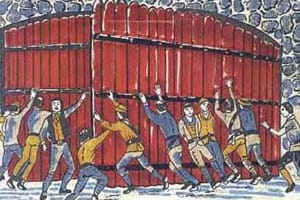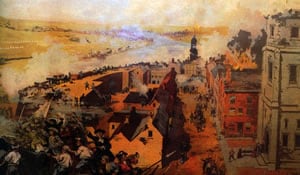For 105 days up to 30,000 Protestant people held the walled city of Londonderry in the face of the Catholic King James II, until the relief fleet broke the boom across the River Foyle on July 28 and the Jacobite forces commenced their retreat on August 1, 1689.
The Siege of Londonderry in 1689
The Glorious Revolution of 1688 is a relatively bloodless revolution in which James II, King of England, Ireland and Scotland and a Roman Catholic convert, is ousted from power by the Parliament of England. The English throne is then offered to his Protestant daughter Mary and her husband William III of England, also known as William of Orange.
In Scotland, the privy council asks William III to assume responsibility for the government in January 1689, and he and Mary are formally offered the Scottish throne in March. The situation is different in Ireland where most of the population are Catholics. Irish Catholics are hoping that James will re-grant their lands, which had been seized from them after the Cromwellian conquest of Ireland (1649–53).
James thus looks to Ireland to muster support in regaining his kingdoms just as his father, Charles I, had done in the English Civil War of the 1640s.
On Monday, the 3rd of December, a letter was found on the streets of Comber, County Down, addressed to Lord Mount-Alexander, a Protestant nobleman of that neighbourhood, professing to be written by a friend, informing him of the intended massacre of Protestant people, and cautioning him to guard against the danger. Copies of the letter are distributed throughout Ireland. With the 1641 Rebellion still in living memory, the letter causes great fear amongst Protestants.

Colonel Philips, a former governor of Londonderry, is worried by the intimidating appearance of the Earl of Antrim’s soldiers. Already unnerved by the Comber letter, he sends a messenger to Derry to tell the citizens to shut the gates.
The intimidating appearance of Redshanks, coupled with the news of the Comber letter and Colonel Phillip’s message, throw the city into a panic.
Although the Anglican Bishop of Derry, Ezekiel Hopkins, wants the citizens to allow the regiment into the city, a group of thirteen apprentices, under the leadership of Henry Campsie, take matters into their own hands and on the 7th of December close the gates against the Redshanks, and seize the Magazine.
The thirteen Apprentices who closed the gates:
- Henry Campsie
- William Crookshanks
- Robert Sherrard
- Daniel Sherrard
- Alexander Cunningham
- John Cunningham
- Alexander Irwin
- James Stewart
- Robert Morrison
- Samuel Hunt
- James Spike
- William Cairnes
- Samuel Harvey
On December 10, King James II flees London. He is caught but flees a second time on December 23 and makes his way to France. On March 12, James II lands in Kinsale with 6,000 French soldiers. He takes Dublin and marches north with an army of Irish and French Catholics.
In April 1689 reinforcements from England arrive under the command of Colonel John Cunningham, who is a native of the city. He is under instructions to take his orders from the Derry City Governor, Lieutenant Colonel Robert Lundy. Lundy advises Colonel Cunningham to leave as arrangements have been made for the city to be surrendered. Lundy calls a meeting with several of his most loyal supporters to discuss surrender. News of the meeting spread, angering many of the citizens. That night, Lundy and many others leave the city and board a ship to Scotland. The city’s defence is overseen by Major Henry Baker, Colonel Adam Murray, and Major George Walker, also an Anglican priest. Their slogan is “No Surrender.”
 As the Jacobite army nears, all the buildings outside the city walls are set alight by the defenders to prevent them from being used as cover by the besiegers.
As the Jacobite army nears, all the buildings outside the city walls are set alight by the defenders to prevent them from being used as cover by the besiegers.
The Jacobite army reaches Derry on April 18. James and his retinue ride to within 300 yards of Bishop’s Gate and demand the surrender of the city. He is rebuffed with shouts of “No surrender!” and some of the city’s defenders fire at him. James asks for surrender three more times but is refused each time. This marks the beginning of the siege. Cannon and mortar fire are exchanged and disease takes hold within the city. James returns to Dublin and leaves his forces under the command of Richard Hamilton.
Royal Navy warships under Admiral George Rooke arrive in Lough Foyle on June 11 but initially decline to ram through the heavily defended defensive boom across the River Foyle at Culmore.
On the 16th of June, the main relief fleet arrives at Culmore Point, joining up with Kirke, and the ships are spotted by the people of Londonderry. On the 25th a messenger sent from the City to the awaiting relief ships drowns, and his letters are captured by the Jacobites. The letters reveal a city in a desperate state of starvation and disease.
Within the city, horseflesh was practically the only meat that could be bought, and of that, the supply was not enough to meet the demand. In their dire need, towards the end of the siege, weeds and herbs were greedily consumed.
The 27th of July saw food prices as follows:
| Item | Pounds | Shillings | Pence | Remarks |
| Horse Flesh sold for | – | 1 | 8 | per pound |
| A Quarter of a Dog | – | 5 | 6 | |
| A Dogs Head | – | 2 | 6 | |
| A Cat | – | 4 | 6 | |
| A Rat | – | 1 | 0 | |
| A Mouse | – | 0 | 6 | |
| A pound of Greaves | – | 1 | 0 | |
| A pound of Tallow | – | 4 | 0 | |
| A pound of salted Hides | – | 1 | 0 | |
| A quart of Horse blood | – | 1 | 0 | |
| A Horse-pudding | – | 0 | 6 | |
| A quart of Meal | – | 1 | 0 | when found |
In case you are wondering, by using the currency converter at The National Archives you will find that one shilling was worth £5.99 in 2017, which would make the cost of a dog’s head around £14.98!
In the evening on the 28th of July, four ships of the fleet, including HMS Dartmouth, the merchant ships Mountjoy, Phoenix and Jerusalem with HMS Swallow’s longboat, make their way to Culmore Point. The Mountjoy and the Swallow’s longboat sail towards the boom with the Phoenix. The ships stop at the boom. Mountjoy strikes the boom, rebounds and runs aground and her captain, Michael Browning, is killed by Jacobite fire. However, the sailors in the longboat cut through the cables and chains of the boom. The ships, under a barrage of fire, are able to make their way through the boom and are towed up the Foyle by longboats to the Ship Quay by 10 o’clock that night unloading many tons of food to relieve the siege.
The city had endured 105 days of siege during which some 4,000 Protestants out of a population of 8,000 are said to have died.
The Jacobite army continues to fire on the town until the 31st of July when they set fire to their camps and retreat to Lifford and Strabane.’General de Rosen, seeing the town relieved with provisions…decamped on the 1st August after fifteen weeks … and losing two thousand men.’

